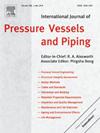Finite element and experimental analysis of residual stresses in G20Mn5 welded joints considering solid-state phase transformation
IF 3
2区 工程技术
Q2 ENGINEERING, MECHANICAL
International Journal of Pressure Vessels and Piping
Pub Date : 2024-12-24
DOI:10.1016/j.ijpvp.2024.105422
引用次数: 0
Abstract
Residual stress (RS) induced during the welding of steel structures can significantly affect their load-bearing capacity. Solid-state phase transformation (SSPT) is essential to the temperature and stress variations during welding, presenting challenges for accurate analysis. Many current numerical simulations overlook SSPT effects in thermal coupling and the key parameters are difficult to obtain. This study enhances the precision of welding simulations by establishing a prediction network for the kinetic parameters of SSPT and introducing a thermal-metallurgical-mechanical finite element program in ABAQUS, which incorporates SSPT. It explores the impact of SSPT on the welding of cast steel welded joints (CSJ). Initially, a predictive model based on the radial basis function (RBF) neural network is developed to determine the kinetic parameters of SSPT for relevant materials, enabling rapid and precise prediction of the base material's SH-CCT diagram. Subsequently, a multi-physics field coupled welding process calculation program is created in ABAQUS software, considering SSPT, latent heat, and associated expansion, its accuracy is validated through experimental cases. Ultimately, the study concludes that the volume change induced by SSPT reduces welding RS, while tensile RS, stress concentration, and welding defects on the inner surface of CSJ increase the risk of structural cracking at the weld root.
求助全文
约1分钟内获得全文
求助全文
来源期刊
CiteScore
5.30
自引率
13.30%
发文量
208
审稿时长
17 months
期刊介绍:
Pressure vessel engineering technology is of importance in many branches of industry. This journal publishes the latest research results and related information on all its associated aspects, with particular emphasis on the structural integrity assessment, maintenance and life extension of pressurised process engineering plants.
The anticipated coverage of the International Journal of Pressure Vessels and Piping ranges from simple mass-produced pressure vessels to large custom-built vessels and tanks. Pressure vessels technology is a developing field, and contributions on the following topics will therefore be welcome:
• Pressure vessel engineering
• Structural integrity assessment
• Design methods
• Codes and standards
• Fabrication and welding
• Materials properties requirements
• Inspection and quality management
• Maintenance and life extension
• Ageing and environmental effects
• Life management
Of particular importance are papers covering aspects of significant practical application which could lead to major improvements in economy, reliability and useful life. While most accepted papers represent the results of original applied research, critical reviews of topical interest by world-leading experts will also appear from time to time.
International Journal of Pressure Vessels and Piping is indispensable reading for engineering professionals involved in the energy, petrochemicals, process plant, transport, aerospace and related industries; for manufacturers of pressure vessels and ancillary equipment; and for academics pursuing research in these areas.

 求助内容:
求助内容: 应助结果提醒方式:
应助结果提醒方式:


